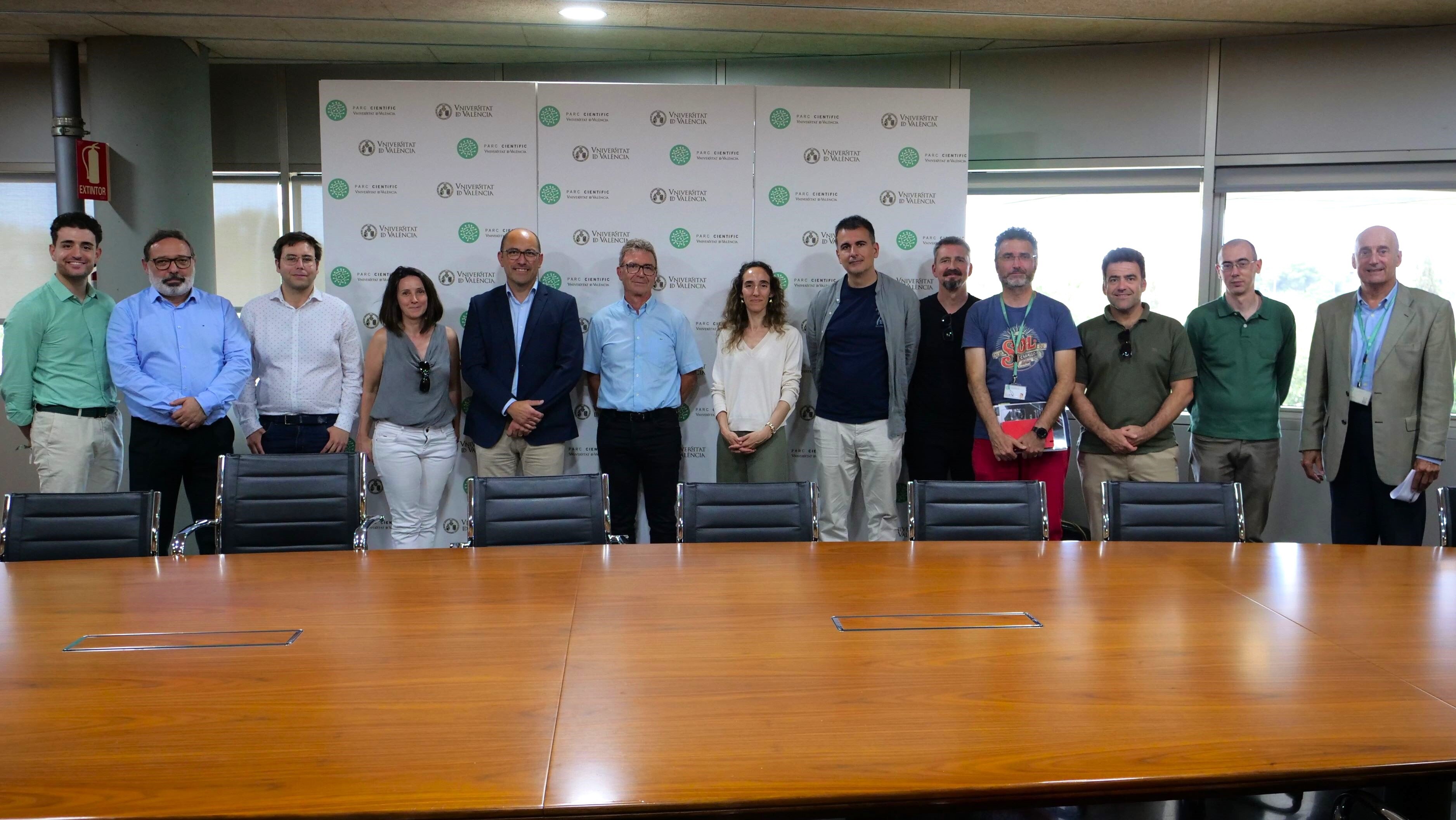The new facilities of the National Dosimetry Center of the National Institute of Health Management (INGESA), to be located in the University of Valencia Science Park (PCUV), will be built on a buildable area of 774 m2 and next to the building that will house the Innovation Center of the University of Valencia, with three floors above ground and two basements, with a total area of approximately 3,000 m2
The opening of the National Dosimetry Center (CND) in the science and innovation ecosystem of the Science Park is getting closer. With the aim of reviewing the available status at the end of the construction work of the annex building to the future building of the NDC and the preparation of the application for the widening of the side road for road access and change of location of the nitrogen tank, and on the maintenance, cleaning, security and locker services to be provided by the PCUV, a meeting was held on June 19, attended by Diego Miguel Holguín, head of the Project Supervision Service of the National Institute of Health Management (INGESA); Cayetana Aguirre, head architect of the Studies and Projects Area of INGESA; Jesús Martínez, architect of SEGIPSA; Marina Alonso, architect of SEGIPSA; Juan Catret, head of the Innovation and Quality Unit of the CND; Pedro Espada, technician of the Innovation and Quality Unit of the CND; Isabel Alonso, technician of VALNU; Fernando M. ª Zárraga, manager of the University of Valencia Science Park Foundation (FPCUV); Vicent Clemente, head of Operations of the FPCUV; Ambrosio Ferrer, director of the Technical Unit of the University of Valencia; David Solves, director of Management and General Services of the CND; and the UV Occupational Risk Prevention Service.
The CND, which depends on INGESA, was created in 1977 to provide external dosimetry services for workers exposed to ionizing radiation, radiological and radioactive facilities of health institutions, control of the radiological groups of the provincial nuclear emergency plans, as well as dosimetry services in university research centers. The future facilities will be added to the Science Park as a space for transferring knowledge to the productive sectors and for promoting research and innovation.
Due to the scope of the project and its report to society, the CND was declared of municipal interest by the City Council of Paterna on December 22, 2023. In addition, more recently, on May 31, 2024, it has been declared a Priority Investment Project for the Valencian Community as an added value in areas such as technological development and innovation, territorial development and structuring, job creation, recovery and promotion of traditional sectors, environmental protection, promotion of social inclusion, equality and conciliation in the workplace or co-responsibility, among other economic, social and environmental criteria.
 The new NDC facilities will be located next to the UV Innovation Center. Photos: FPCUV
The new NDC facilities will be located next to the UV Innovation Center. Photos: FPCUV
One of the largest centers in Europe to manage active dosimetric histories
In December 1983, the National Dosimetry Center was authorized by the Nuclear Safety Council (CSN), the only competent body for nuclear safety and radiation protection in Spain, to act as a Personal Dosimetry Service (SDP). In Spain there are 114,444 workers providing services in medical, industrial or research radioactive facilities. The CND acts as a PDS managing 61,605 active dosimetry histories, which makes this center the largest existing service in Spain and one of the largest in Europe in terms of volume of dosimetry readings. The function of a PDS is to carry out individual dosimetric monitoring, that is, to directly determine the monthly doses of radiation received by workers throughout their bodies. This service is provided by means of lapel, wrist or lens dosimeters that the exposed worker must wear during the working day. At the end of the month, the dosimeter is sent to the SDP for reading. In the meantime, the SDP provides the worker with another dosimeter to replace the one being read.
The CND was authorized by the Nuclear Safety Council (CSN) in January 1984 as a Technical Radiation Protection Unit (UTPR). In 2024, the CND was responsible for the radiological protection of more than 206 ionizing radiation producing equipment within its scope, such as conventional radiology equipment, CT scanners, mammographs, orthopantomographs and other equipment of medical diagnostic facilities. The UTPRs are entities external to the radioactive and nuclear facilities that are entrusted with the performance of radiation protection functions. These include the classification and marking of areas according to the risk of exposure to ionizing radiation; the definition of the rules for access, stay and work in them; and the verification that workers are free of nuclear or radioactive contamination. Since 1993, the CND has also had an ionizing radiation metrology laboratory for the calibration of measuring instruments and for the irradiation of personal dosimeters in protection and diagnostic energies.
The CND has been part of the Hospital la Fe in Valencia as another service until 1986, when it was provided with its own staff and budget, becoming a unit physically separated from the rest of the hospital services. However, in 1999 it was moved to provisional facilities within the Hospital la Fe grounds, while a definitive location was being sought due to the need of the Valencian Health Service for space in the building. In order to definitively resolve the provisional nature of the CND facilities, INGESA once again promoted institutional collaboration. This time with the University of Valencia (UV), an entity with which in 2018 it signed a property contract for the transfer of land in the Science Park on which the future premises of this national Center will be built.


